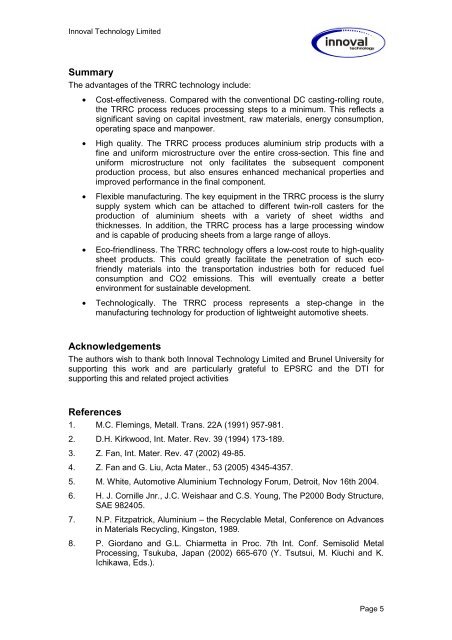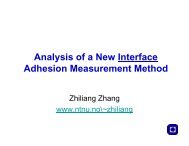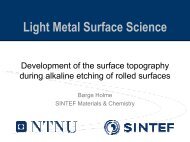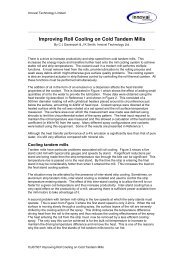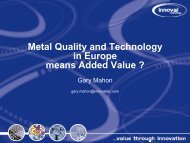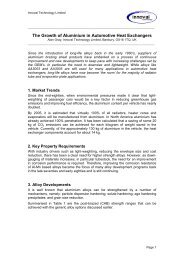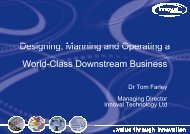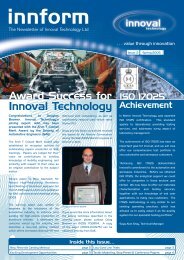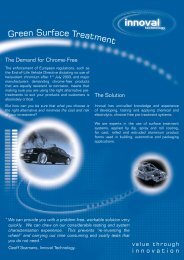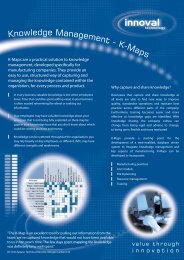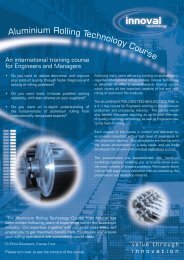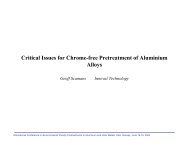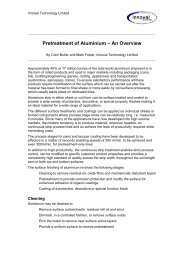Twin Roll Rheocasting of Aluminium Alloys - Innoval Technology Ltd
Twin Roll Rheocasting of Aluminium Alloys - Innoval Technology Ltd
Twin Roll Rheocasting of Aluminium Alloys - Innoval Technology Ltd
You also want an ePaper? Increase the reach of your titles
YUMPU automatically turns print PDFs into web optimized ePapers that Google loves.
<strong>Innoval</strong> <strong>Technology</strong> Limited<br />
Summary<br />
The advantages <strong>of</strong> the TRRC technology include:<br />
• Cost-effectiveness. Compared with the conventional DC casting-rolling route,<br />
the TRRC process reduces processing steps to a minimum. This reflects a<br />
significant saving on capital investment, raw materials, energy consumption,<br />
operating space and manpower.<br />
• High quality. The TRRC process produces aluminium strip products with a<br />
fine and uniform microstructure over the entire cross-section. This fine and<br />
uniform microstructure not only facilitates the subsequent component<br />
production process, but also ensures enhanced mechanical properties and<br />
improved performance in the final component.<br />
• Flexible manufacturing. The key equipment in the TRRC process is the slurry<br />
supply system which can be attached to different twin-roll casters for the<br />
production <strong>of</strong> aluminium sheets with a variety <strong>of</strong> sheet widths and<br />
thicknesses. In addition, the TRRC process has a large processing window<br />
and is capable <strong>of</strong> producing sheets from a large range <strong>of</strong> alloys.<br />
• Eco-friendliness. The TRRC technology <strong>of</strong>fers a low-cost route to high-quality<br />
sheet products. This could greatly facilitate the penetration <strong>of</strong> such ec<strong>of</strong>riendly<br />
materials into the transportation industries both for reduced fuel<br />
consumption and CO2 emissions. This will eventually create a better<br />
environment for sustainable development.<br />
• Technologically. The TRRC process represents a step-change in the<br />
manufacturing technology for production <strong>of</strong> lightweight automotive sheets.<br />
Acknowledgements<br />
The authors wish to thank both <strong>Innoval</strong> <strong>Technology</strong> Limited and Brunel University for<br />
supporting this work and are particularly grateful to EPSRC and the DTI for<br />
supporting this and related project activities<br />
References<br />
1. M.C. Flemings, Metall. Trans. 22A (1991) 957-981.<br />
2. D.H. Kirkwood, Int. Mater. Rev. 39 (1994) 173-189.<br />
3. Z. Fan, Int. Mater. Rev. 47 (2002) 49-85.<br />
4. Z. Fan and G. Liu, Acta Mater., 53 (2005) 4345-4357.<br />
5. M. White, Automotive <strong>Aluminium</strong> <strong>Technology</strong> Forum, Detroit, Nov 16th 2004.<br />
6. H. J. Cornille Jnr., J.C. Weishaar and C.S. Young, The P2000 Body Structure,<br />
SAE 982405.<br />
7. N.P. Fitzpatrick, <strong>Aluminium</strong> – the Recyclable Metal, Conference on Advances<br />
in Materials Recycling, Kingston, 1989.<br />
8. P. Giordano and G.L. Chiarmetta in Proc. 7th Int. Conf. Semisolid Metal<br />
Processing, Tsukuba, Japan (2002) 665-670 (Y. Tsutsui, M. Kiuchi and K.<br />
Ichikawa, Eds.).<br />
Page 5


